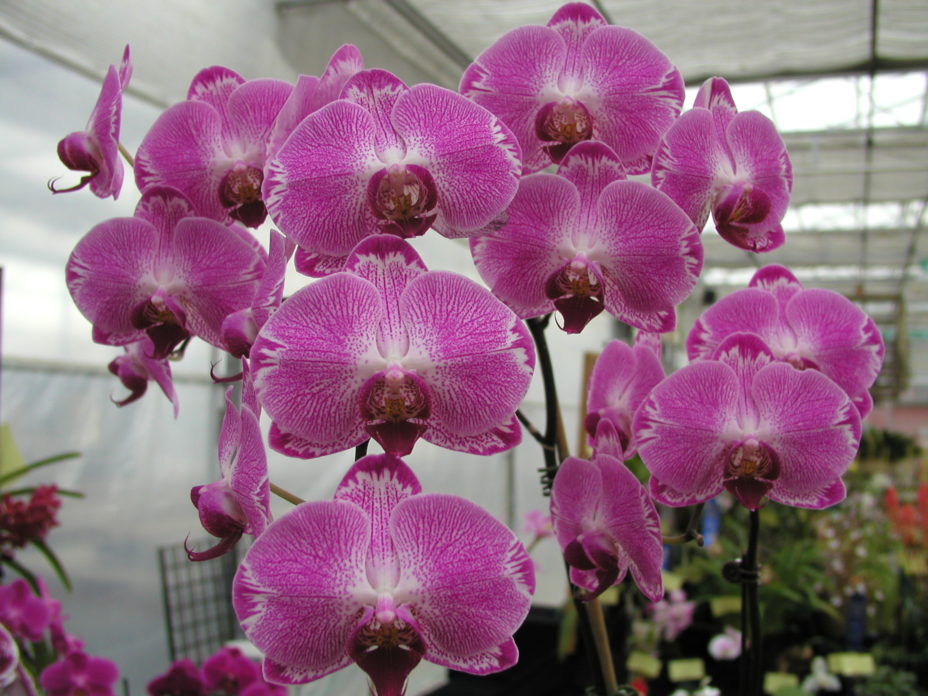Getting Those Orchids to Bloom Again
In June, Chuck McClung spoke to the Garden Club about orchids. Interested in gardens and gardening since early childhood, McClung received a master’s degree in botany from Washington State University and has worked in ecological and botanical research for several universities as well in commercial greenhouses and nurseries. McClung explained he has over twenty years’ experience working in large, family-owned independent garden centers “where I really honed my skills helping others find happiness successfully growing and tending to their favorite plants.” Today he is a gardening instructor, an author, and a specialist in orchids as well as landscape design which includes everything from maintenance to edible landscapes as well as “personalized garden mentoring.” His talk focused on getting orchids to rebloom.
McClung says if you know three basic factors, you will have success with your orchids: you must know what kindof orchid you have; you must know what the native habitat is like for that orchid; and you must be able to recreate the conditions found in that particular orchid’s native habitat. McClung says, “The goal for any type of gardening is to reproduce the native habitat of our plant (orchid) to achieve the desired growth habit (flowers), while having lots of fun.”
Exercise caution when learning about your plants on the internet. Visit your local nursery or ask someone who really knows his plants. What are its growth patterns each year? Where does it grow in nature? What is the climate like over the year? Most orchids live in trees and are called epiphytes; however, some do live in soil. While some orchids grow at high altitudes, others live at lower elevations. Some like more humidity than others; some like more light; some prefer shade; some grow in full sun.
If an orchid has not rebloomed in a year or two, McClung explained that “some aspect of its native habitat must be missing.” He says this is probably due to five main considerations: the kind and amount of light it requires; the amount of water, humidity, and fertilizer it receives; the temperature of its environment; what it is planted in including the media and the container; and the state of the plant’s health when you first received it.
You must know the plant’s light requirements. Some require a little direct sun. Others may burn when exposed to direct sunlight. Will artificial light satisfy its requirements?
The most common cause of orchids’ death is too much water. Their roots need both air and water. Too much water prevents the roots from being able to take in air. McClung compares it to keeping a human being at the bottom of a pool. No air, no life! “When in doubt, don’t water,” McClung cautions. Plants need most water when they are growing leaves; they do not require as much when they are flowering. He also advocates watering the pot instead of the plant. Provide extra humidity. A saucer of water filled with rocks can allow a pot to rest on the rocks while the water beneath the rocks provides humidity. Do NOT over fertilize. Follow the directions for feeding orchids.
How do you know when to water? McClung says do NOT use a water meter; it is designed for use in a more soil-like medium, not in media for orchids. Your finger can detect dampness. Many orchids can tolerate going without water longer periods than most other plants. An orchid’s roots cannot survive without oxygen, so too much water will kill them. If you don’t want to use your finger, use a thin wood dowel or a sharpened pencil. Wood stains when damp and is an excellent indicator or your plant’s moisture needs.
Be sure your orchid receives temperatures found in its native habitat and that the temperature at night is cooler than during the day. If your orchid likes a warm climate, say in the low 70s, it probably expects the temperature to drop at night. If you run your heater at night, your plant will not get its customary drop in temperature. Some plants tend to bloom in cooler temperatures; others prefer heat for flowering. “Know your plant!” McClung reminds us.
Improper potting medium, wrong size containers, or repotting incorrectly can also prevent orchids from reblooming. McClung pointed out that orchids typically are purchased in plastic pots which are fine for many orchids. Roots do not get stuck on plastic whereas they may attach to unglazed terra cotta. Repotting may damage those roots. A glazed pot is safer; a pot with holes on the sides and bottom is even better. McClung continued, “When repotted, some orchids will require a larger pot, and some may not; know your plant!” You also need to know what type of potting medium your particular plant requires. Some orchids thrive in coarse bark; some fair best in medium or fine texture. Orchids should never be repotted before or during the blooming period, unless, of course, it is a victim of an accidental fall. Orchids are usually repotted when new growth appears, typically in spring or summer.
Finally, what was the origin of your plant? Was it overwatered and has rotten roots? Is it so dehydrated that the entire pot seems light? You may be able to nurse a sickly orchid back to life. If it was in bad shape before you got it, you may wait a year or two for it to recover.
I was delighted to get this general information on helping orchids to rebloom. For more detailed information on specific varieties of orchids, McClung has written a book, “How Orchids Rebloom.” It is an easy-to-follow guide to growing flowering orchids. Go to his website: www.howorchidsrebloom.com or write him at howorchidsrebloom@gmail.com.
To learn about the September program for the Mission Hills Garden Club, visit
www.missionhilsgardenclub.org.

Category: Education, Entertainment, Events, Gardening, Life Style, Local News, Nonprofit







